
Rupert’s Word: Sound Quality & Harmonic Distortion
Sound Quality & Harmonic Distortion
How often have you eagerly opened a new software package, or even a new computer, and seen those inviting words: Getting Started? How often have you read the words of wisdom that follow? “Unwrap the floppy disks and make back-up copies. Place DISK #1 into drive A. Close the door and type A:lnstall” After a bit of experience you become an expert on this stuff and it all comes naturally. Next, you become an ‘Authority’ and tell your friends that software should be instinctive. “l never read the handbook, I don’t have time to mess about… Just hit it and go”. Your more impressionable friends think: “Wow, he really knows his stuff.” They will ask you diffidently to pop round for a coffee and “help sort out my computer.” Now the chips are down!
At an early stage I learned the golden rule of consultancy: “Never give advice you don’t know how to implement or are not prepared to carry out.” However, I have to admit that my type of ubiquitous background would probably not work today. At the start of my career, after World War II, technical training and University Degree courses in our field hardly existed. I learned how from generous older and wiser engineers, and became QBE (Qualified By Experience) and QBD (Qualified By Doing)!
Whereas it used to be okay to know a little about everything, now you have to home in on a subject, specialise and become the number one ‘Authority’. You have to learn more and more about less and less — you have to know a lot about a little.
Think for a moment about the famous inventors from the past. They were often starting from scratch. Every design depended for its success on imaginative improvisation. They had enormous vision — an overwhelming desire to give practical expression to an idea. I wonder if, today, we are shoe-horning our most brilliant brains into closed boxes with windowless walls; stifling their vision and imaginative energy. Specialisation is a ‘must’ and many inventions or development projects today are the result of co-operative effort and combined skills. But is it satisfying? Fulfilling? Well, of course it often is. But, if you could implement your own vision – what a thrill!
I shall never forget Bill, who, in the very early days of Neve, came to us initially as a ‘wireman’ to help cable up patch fields and consoles. He showed a lot of initiative so we asked him to organise the production of a complete small console (a PSM6). This entailed getting all the parts together, processing metalwork and woodwork, getting the modules made and wired and, of course, the console shell itself. He performed brilliantly, but when the console was finished we could not get it out of his hands — he was too busy stroking it and loving it. He said, “You see, Mr Neve, I’ve only worked on a production line before, stuffing part of a printed circuit – I didn’t even know what it was for. This is the first time I’ve ever seen anything through from start to finish.” I might say that gave us a lot of pleasure too!
Bill’s satisfaction came from seeing a project through from beginning to end, understanding the steps along the way and knowing why things were done in a particular manner. No matter what area of audio you specialise in – recording, mixing, post-production, concert sound or whatever — a wider understanding of the foundations of sound quality and the measurements of sound equipment is worthwhile in helping us to fulfil our individual vision.
And so to getting started in this business of sound quality, I often think of the old-timers. In 1877 Lord Rayleigh said: “Directly or indirectly, all questions connected with this subject must come for decision to the ear, as the organ of hearing; and from it there can be no appeal. But we are not, therefore, to infer that all acoustical investigations are conducted with the unassisted ear. When once we have discovered the physical phenomena which constitute the foundation of sound, our explorations are in great measure transferred to another field lying within the dominion of the principles of Mechanics. Important laws are in this way arrived at, to which the sensations of the ear cannot but conform.” [1]
How did he know? What was his standard? What speakers or amplifiers did he use for his ‘acoustical investigations’ and ‘explorations’? Lord Rayleigh was clearly a man of vision, able to look forward to – and beyond – the sort of quality sound reproduction we enjoy today.
Sound quality — how do you ultimately define or assess it? With the ear? Yes, because regardless of facts and figures and enthusiastic salesmen, if you don’t like it then it’s not good enough. Facts and figures don’t tell the full story about the performance of high grade equipment. Humans are able to perceive minutely small quantities of distortion noise and ambience and reference it to a stored memory bank of experiential sound. There is no specification which can define all the parameters that go towards making a pleasurable musical experience – but that, surely, is what we aim for.
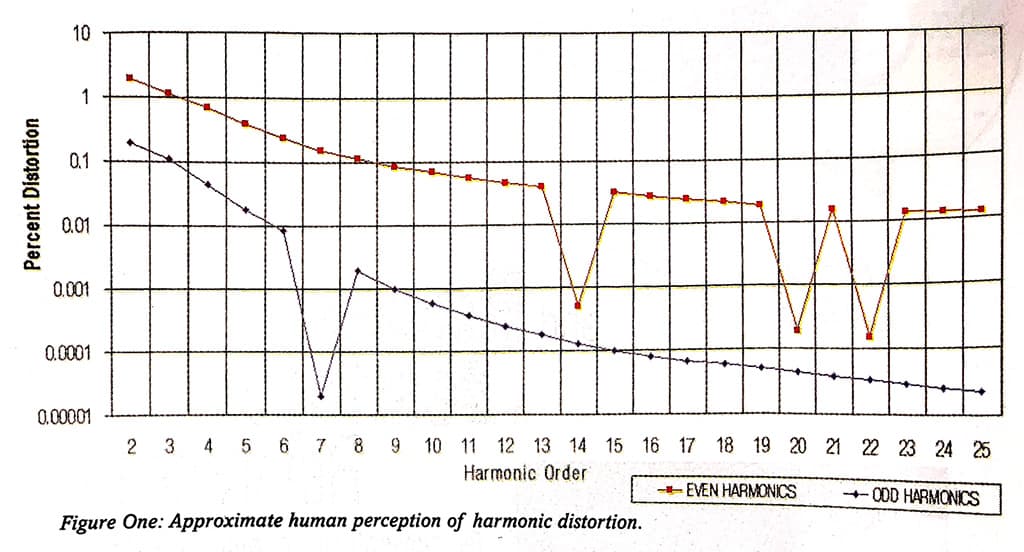
HARMONIC DISTORTION
There are some specifics which we can explore, although many of these have been known for a long time. For example, high order harmonics not present in the original music are either concordant or discordant. We can perceive differences even when the quantities are well below the noise floor and beyond the accepted limits of hearing. It must be possible ultimately to fully define audio performance in numbers but the question before us is, “What are we supposed to measure?” If we define distortion as the presence of anything not in the original signal, then all we have to do is compare the amplified signal with the original signal and we have quantified the problem. Right? Yes, provided there was some chance of finding a perfect amplifier. There isn’t one! So we have to settle for compromise and weigh up the things that are important. How deep do we have to dig?
Langford-Smith, in the 1940 edition of The Radio Designer’s Handbook [2] (by the way, this was first published in 1934 in Australia as The Radiotron Designer’s Handbook!) enumerates the arbitrary percentages of 2nd, 3rd, 4th, 5th, 6th and 7th harmonics permitted for ‘good fidelity’ and shows that they decrease steeply with increasing harmonic order. He states that “…the 7th harmonic is not on the musical scale and should therefore be below the threshold of audibility.” He also quotes from a paper published in ‘Electronics’ in 1938 by D. Masa who says: “The total harmonic distortion (THD) is not a measure of the degree of distastefulness to the listener and it is recommended that its use should be discontinued.” [3]
So, more than 60 years ago it was known that the high order odd harmonics produced a very adverse and non-musical sound which needed to be defined yet how often have you seen amplifier specs with “THD and Noise less than 0.1%” or some such statement which groups all harmonics together, along with the noise?
Human sensitivity to distortion increases dramatically with the order of the harmonic content and, from work done by James Moir and D.E.L. Shorter as long ago as 1951, seems to increase by about 12dB for every harmonic above the third. (I attended a British Institution of Radio Engineers symposium in 1951 and heard James Moir on this. Unfortunately I have since lost the papers!) The effect of harmonic content is not only confined to amplitude. Langford-Smith, again, this time in the fourth edition of The Radio Designers Handbook says: “The 7th, 9th, 11th, 13th, 14th, 15th, 17th, 18th, 19th, 21st, 22nd, 23rd, and 25th harmonics are musically dissonant. In fact, the 7th harmonic does not appear in the musical scale and if distorting equipment puts it there the effect is very harsh and non-musical.” [4]
Alec Nisbet, in The Technique of the Sound Studio [5], describes clearly how, on a stringed instrument, where overtones are exact multiples of the fundamental, different harmonics can be emphasised by bowing at different fractions of the length of the string: “If the string is bowed at approximately one-seventh of its length it will not produce the seventh harmonic. So this is a good point at which to bow, because as it happens the seventh harmonic is the first that is not musically related to the rest – though the sixth and eighth are both members of the same musical family and there are also higher harmonics produced in rich profusion to give a dense tonal texture high above the fundamental.”
Figure One is a graph I have produced based on studies by others and my own listening. It shows the relative levels of harmonic distortion perceived by the average listener. The horizontal axis shows the harmonic order of the distortion, while the vertical axis shows the amplitude of that distortion (as a percentage of total signal amplitude) required for it to be perceived. Note the very low level required for the 7th harmonic to be perceived, relative to all other harmonics.
When we design sound equipment, we have to be very careful to pass all the naturally occurring harmonics without introducing artificial ones from bad amplifier circuits. Crossover distortion is one example, but that’s for a future issue. In the meantime, there’s a lot more that can be explored.
1. Lord Rayleigh in ‘The Theory of Sound’, first edition 1877
2 D. Langford-Smith. ‘The Radio Designer’s Handbook’, 1st British edition, December 1940. Ch5.
3 D. Masa, ‘Combination tones in Non-linear Systems’ Electronics. Sept 1938, p20.
4 Chapter 14, ‘Radio Designer’s Handbook’, Fourth Edition, Published by Wireless World. London 1953
5 ‘The Technique of the Sound Studio’, by Alec Nisbett. Ninth Impression 1974. Focal Press Ltd. ISBN 0 2404491 6

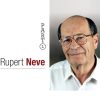
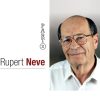








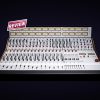





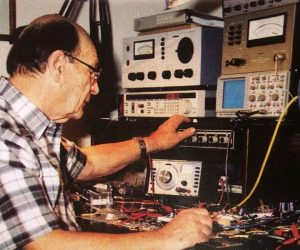




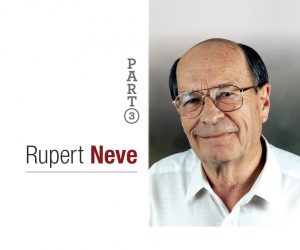



RESPONSES